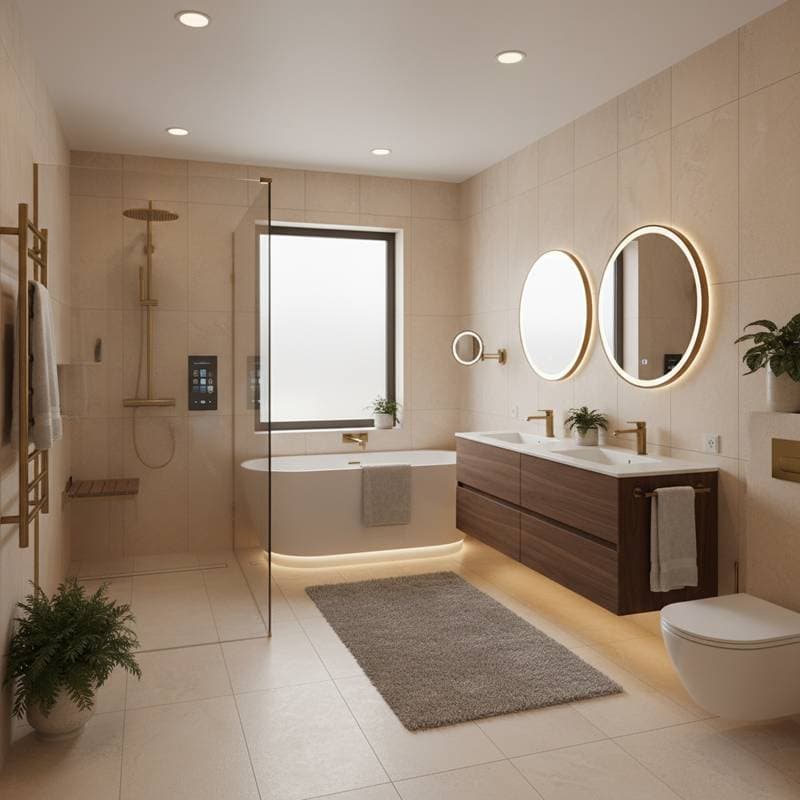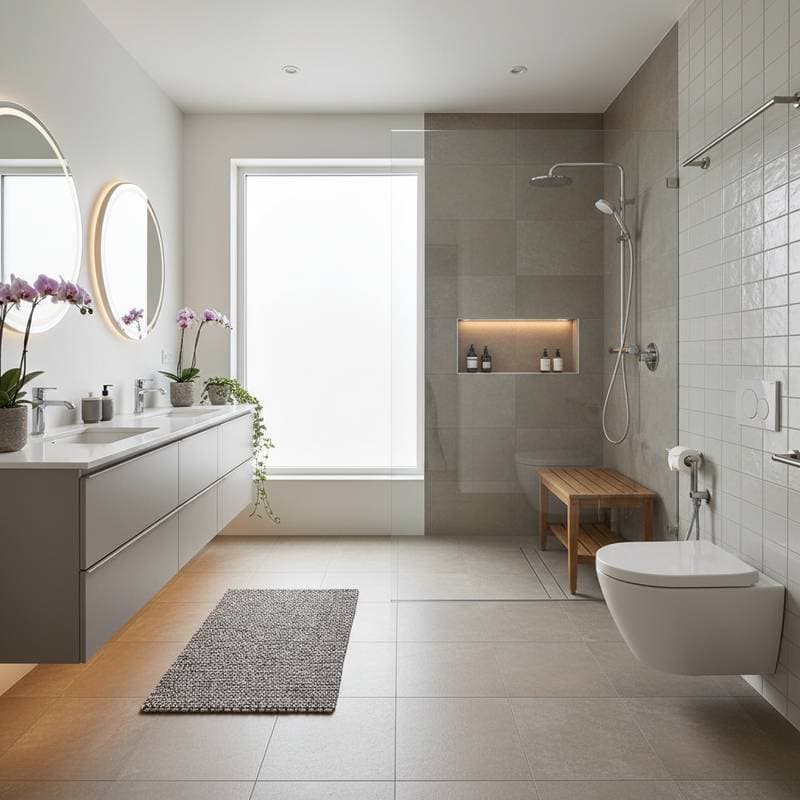Japandi Wet Rooms: 2025's Ultimate Bath Trend
Homeowners increasingly view bathrooms as more than functional spaces. The Japandi wet room emerges as a leading design evolution, combining Japanese serenity with Scandinavian simplicity. This approach integrates minimalism, natural materials, and open layouts to foster a spa-like environment that performs reliably.
As a contractor experienced in such projects, I observe how these designs convert confined areas into serene havens. The apparent ease of the final space demands meticulous planning and execution. Success hinges on thorough preparation, effective waterproofing, and informed material selections to avoid common pitfalls.
Why Japandi Wet Rooms Capture Interest
A wet room removes barriers between the shower and floor, permitting water to flow across a unified surface. This configuration enhances openness and accessibility, suiting compact homes or preferences for streamlined aesthetics. Japandi elements introduce warm, organic textures and subdued earthy tones, grounding the area without sterility.
The appeal stems from key homeowner priorities:
- Reduced Maintenance: Minimal seams, doors, and dividers simplify cleaning and limit mold-prone areas.
- Serene Visuals: A palette of stone, wood, and muted neutrals minimizes clutter.
- Eco-Friendly Focus: Sustainable materials and water-efficient features align with contemporary environmental values.
Beneath this streamlined appearance lies intricate technical implementation. Proper construction adheres to stringent waterproofing protocols to avert leaks and structural harm.
Potential Pitfalls of Improper Installation
Repairs on unsuccessful wet room setups reveal recurring issues rooted in subpar waterproofing or flawed gradients. Water exploits vulnerabilities relentlessly. An incorrect floor slope leads to standing water, while a faulty membrane allows seepage into subfloors and walls, resulting in decay or mold that demands substantial remediation costs.
Frequent errors encompass:
- Insufficient Subfloor Readiness: Existing bases require leveling or fortification prior to tiling; oversight yields irregular drainage.
- Misplaced Drains: Even slight offsets, such as half an inch, provoke persistent pooling.
- Unsuitable Materials: Unsealed porous tiles or grout invite ongoing upkeep challenges.
- Overlooked Ventilation: Unmanaged moisture fosters mildew and compromises indoor air.
Addressing these demands foresight, as retroactive fixes prove costly. A genuine Japandi wet room prioritizes accuracy from inception.
Essential Steps for Durable Construction
Contractors achieve reliability by initiating processes well before surface applications. The following outline represents the protocol applied to each project, guaranteeing longevity and efficacy.
1. Structural Evaluation
Begin by verifying the floor's capacity to withstand heightened moisture and tile loads. In legacy structures, install cement backer board or a waterproof underlay to secure the foundation. Neglecting this invites potential water ingress.
2. Comprehensive Waterproofing
Apply a seamless waterproofing membrane across the entire floor and lower walls. Reinforce corners and junctions with specialized sealing strips. Conduct a 24-hour water retention test post-application but pre-tiling to validate integrity, safeguarding both installer and owner.
3. Precise Sloping and Drainage
Incline the floor toward the drain at a rate of one-quarter inch per foot. Excessive pitch risks safety; insufficient angle retains moisture. Opt for linear drains positioned along walls to harmonize with Japandi visuals and streamline tiling patterns, promoting fluid aesthetics.
4. Strategic Material Choices
Japandi aesthetics favor enduring, natural finishes. Recommended options include:
- Porcelain or Stone-Mimicking Tiles: These offer resilience, minimal porosity, and subtle matte finishes.
- Cedar or Teak Elements: Such woods resist humidity while infusing warmth and utility.
- Subdued Color Range: Tones like beige, gray, sand, and soft clay enhance natural illumination.
Steer clear of glossy surfaces, which amplify reflections and heighten slip hazards.
5. Integrated Ventilation and Illumination
Effective air circulation proves vital. Install a low-noise, constant exhaust fan to uphold tranquility while curbing excess humidity. Layer lighting with overhead recessed fixtures for broad coverage and hidden LED tapes beneath seating or recesses for ambient, restorative effects.
Harmonizing Form and Function
Enthusiasm for Japandi wet room visuals often overlooks the engineering that ensures endurance. Optimal outcomes merge restraint with utility. Each component serves a defined role, from water management to convenience.
To sustain minimalism alongside practicality, incorporate:
- Recessed Shelves: These store essentials discreetly, preserving sleek profiles.
- Wall-Mounted Vanities: Such units foster spaciousness and facilitate hygiene.
- Radiant Floor Heating: This mitigates chill on surfaces and accelerates evaporation.
- Translucent Glass Dividers: They provide seclusion without enclosing the volume.
These refinements align with Japandi ethos while meeting routine demands.
Regulatory and Budgetary Aspects
Wet room undertakings elevate contractor accountability due to water-related risks. Document all waterproofing measures and secure supplier guarantees to mitigate claims. Owners merit detailed records, including system specifications and verification reports.
Plumbing or drainage modifications typically necessitate approvals. Bypassing regulations may yield short-term gains but complicate sales or coverage later. Verify your professional holds credentials and protection specific to waterproofing, beyond basic renovations.
Initial expenses exceed conventional showers, yet superior components and execution yield savings via durability and minimal upkeep. This enhances asset worth over time.
Sustaining Your Investment
Japandi wet rooms endure through intentional upkeep, preserving both performance and poise.
- Grout Maintenance: Apply pH-balanced solutions periodically to clear buildup without harming surfaces.
- Sealant Checks: Renew caulking at signs of wear to block ingress.
- Post-Use Care: Employ a squeegee routinely to eliminate residues and inhibit growths.
- Humidity Control: Operate the fan for a minimum of fifteen minutes following use.
Consistent practices prolong material integrity and uphold the design's essence.
Realizing Enduring Tranquility
The Japandi wet room transcends trends, embodying deliberate spatial philosophy. Executed with care, it evolves into a restorative anchor that bolsters well-being and equity.
Drawing from numerous installations, enduring examples arise from integrated vision and skill. For your project, emphasize groundwork, records, and collaboration with specialists to secure a timeless outcome.









